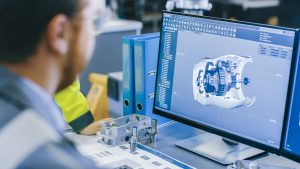Most products are incremental improvements on a previous version. Many parts in a new product can be reused from previous work. Research shows reusing a previously specified part can save anywhere between $4,500 and $23,000 per part, on average. The savings don’t stop there. On average according to a recent report by Tech-Clarity, engineers spend about 33% of their time on non value-added work such as searching for existing parts within the company that can be reused, or even recreating an existing part that cannot be found in a timely manner. If a manufacturer can reduce the time spent searching for or designing parts, the savings multiply.
An efficiency consultant recently told me about a conversation with an engineer.
“When I need a part,” the engineer said, I will search an hour before I give up and design a new one.” In this example, the engineer had to comb through 15 unique engineering data vaults created by two software vendors, plus the company’s ERP system created by a third vendor.
said, I will search an hour before I give up and design a new one.” In this example, the engineer had to comb through 15 unique engineering data vaults created by two software vendors, plus the company’s ERP system created by a third vendor.
Parts data is usually stored in multiple locations—the proverbial silos—and formats. And even if the silos have been broken down, existing search methods for parts rely on keyword or (less often) key shape inquiries. If the words or shapes are not exact, or if the relevant data has not been manually added to a database, an engineer could easily be led to believe the part sought is not in the company database or otherwise accessible. Taking longer to source parts means projects take longer to reach the market and cost more to build.
Inadequate data about parts and inadequate access to sourcing parts create four structural problems within the organization:
- Operational inefficiency: Dispersed parts data requires the use of a wide variety of search techniques, including reading long lists.
- Poorly informed make-or-buy decisions: The engineer quoted above believed time was the only resource in question, resulting in limited patience to seek out previously sourced parts.
- No cross-program standardization: The more projects in an organization, the greater the likelihood one of those programs has previously sourced parts another project needs. But without standardization, engineers are often flying blind in their searches.
- Weak procurement performance: Inefficient internal sourcing forges a weak link in the supply chain that can be hard to remove. Once it has been “documented” that a part is not available internally, it becomes “fake news” and hard to correct.
The solution is sourcing and standardization intelligence . The use of artificial intelligence (AI) and machine learning (ML) offers the opportunity to unify separate and unstructured data systems, allowing for better access to data, better decisions, and faster design.
AI/ML algorithms can simplify organizing all the data in an organization. The goal is to get a comprehensive view of all parts, whether internal or external to the organization. The new generation of software can identify not only if a part is available, but if there are multiple vendors for it, check for cost differences, and compare for subtle differences not initially obvious.
Using intelligent sourcing and standardization does more than identify parts across disparate data silos. It can also extend the life of these existing silos by postponing or eliminating the need to replace them with a more modern approach. Don’t toss out your manufacturing ERP software, MPR, or PLM; instead, use an algorithmic solution to find what’s there.
AI for sourcing and standardization is agnostic to CAD and PLM standards. It can be trained to be very efficient about identifying shape  and feature similarity. It provides a holistic view of the organization’s internal and external parts, without having to move from one kind of dashboard to another.
and feature similarity. It provides a holistic view of the organization’s internal and external parts, without having to move from one kind of dashboard to another.
Your content stays where it is, which means existing security does not have to be replaced. If you are subject to ITAR or export control regulations, this is a huge consideration. The solutions also allow engineering teams to discover parts and related information without another division having to relinquish control.
AI for sourcing and standardization helps overcome the four structural impediments listed above. Operational efficiency improves as data silos no longer stand in the way of finding information. Make-or-buy decisions are based on complete knowledge. Standardization becomes possible as all the variations in available parts are discovered. Procurement becomes stronger when it relies on accurate information, strengthening the relationship between engineering and procurement and enabling the latter to negotiate better deals and improve supply chains.
##
Editor:
Making is a last resort. AI-driven intelligent product part reuse, standardization and sourcing empowers engineers, designers and procurement to quickly make the best decision, freeing up the time previously wasted searching for the right parts, devoting it instead to creating new and better products.
To learn more:
- Watch the webinar replay with Dassault Systèmes experts hosted by engineering.com, called Improve Product Design with AI-Driven Parts Standardization
- Download our e-book, Optimize Product Design with the Right Parts Sourcing and Standardization
